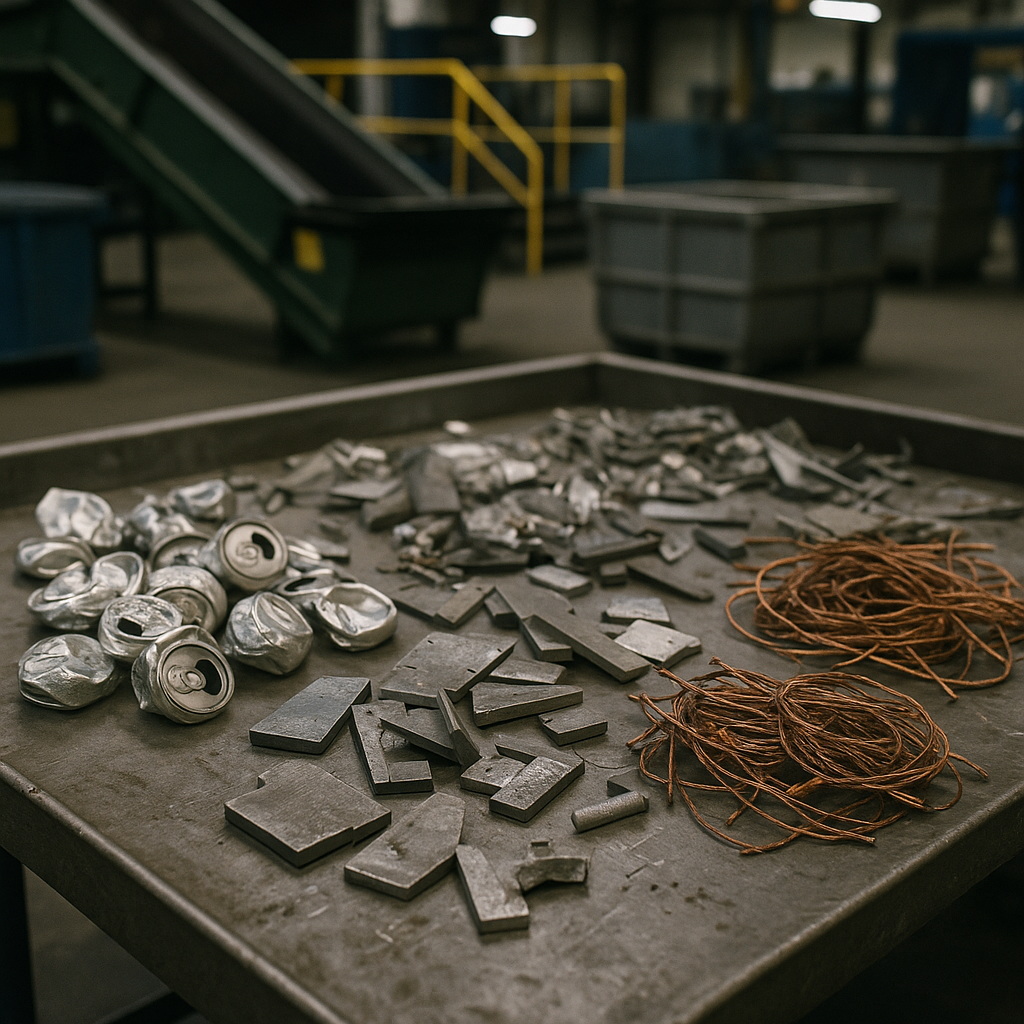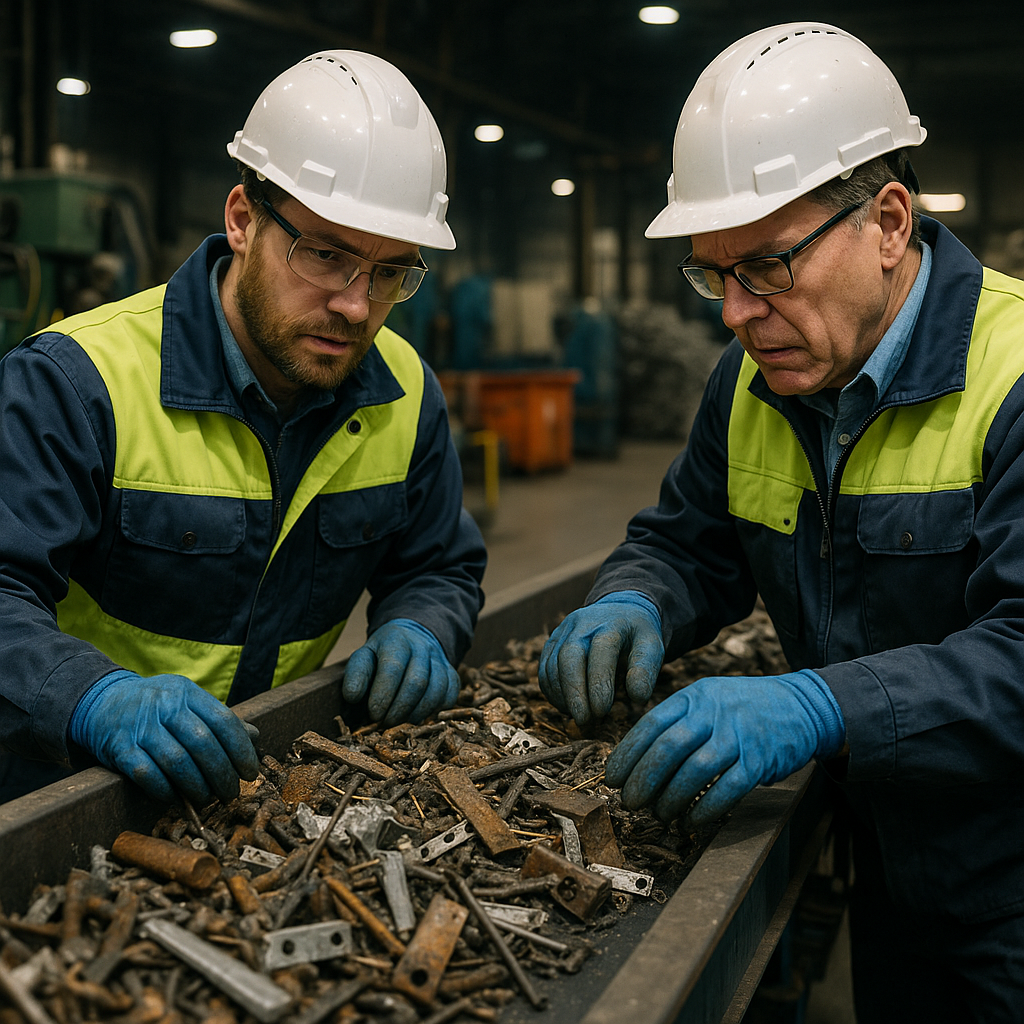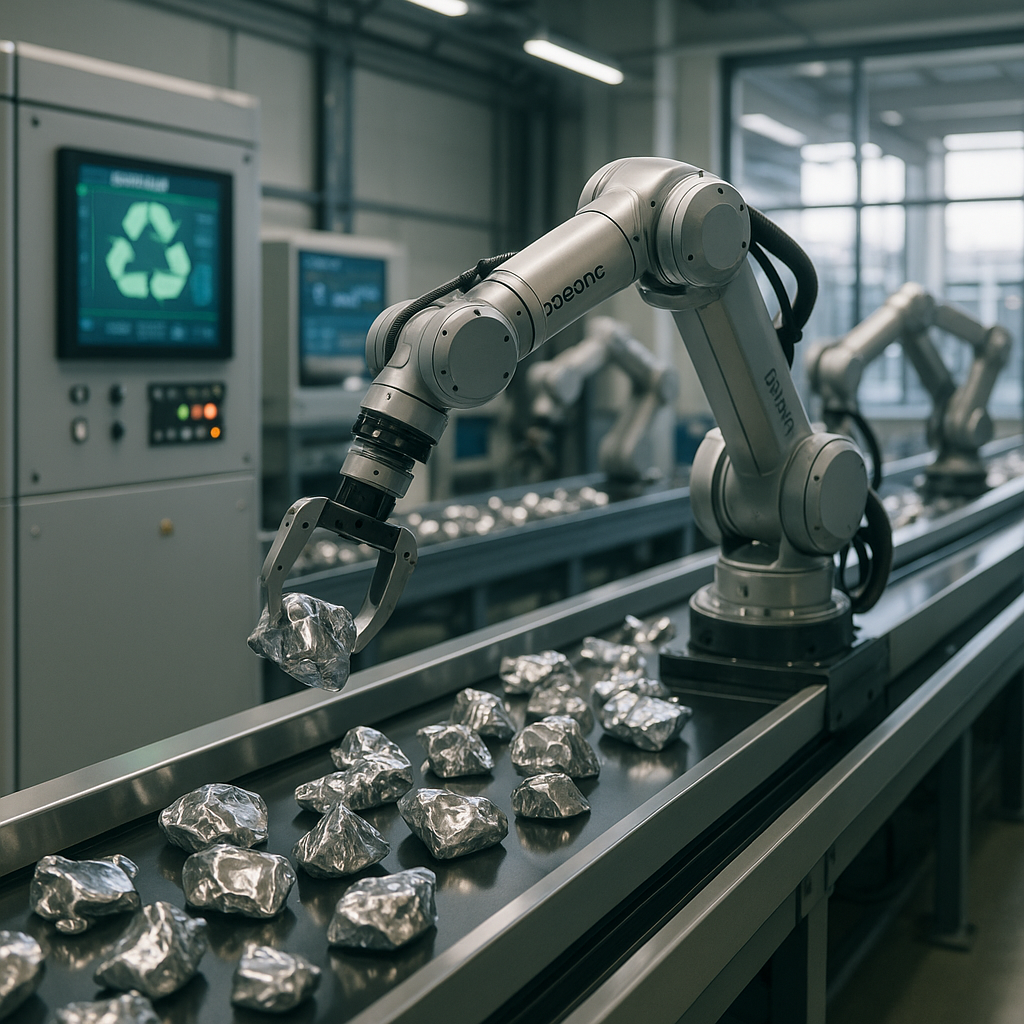5901 Botham Jean Blvd, Dallas, TX 75215
Learn About Alloy Recycling, the Process, and the Challenges
September 16, 2025Every year, more than 25 million tons of metal waste are generated by the construction industry alone. This significant amount underscores the necessity of alloy recycling in our resource-conscious world. Alloy recycling involves recovering and reusing metal alloys—combinations like steel, bronze, brass, and other specialty metals—from scrap materials and turning them back into valuable resources.
Alloy recycling serves as one of our most effective tools for creating a sustainable future. When we recycle aluminum, for instance, we save up to 95% of the energy required to produce it from raw ore. This equates to energy savings equivalent to 21 barrels of oil for every ton recycled. These materials possess unique properties that make them essential across industries, emphasizing the importance of their conservation.
The benefits of alloy recycling go beyond energy savings. By diverting metals from landfills, we prevent soil and water contamination from hazardous substances. The process significantly reduces greenhouse gas emissions, with recycled steel cutting carbon emissions by up to 58% compared to primary production. Crucially, metals like copper, nickel, and zinc are finite resources. Recycling ensures these valuable materials remain in circulation, supporting both environmental sustainability and economic growth.
What Are the Different Types of Recyclable Alloys?

Alloys are created by combining two or more metals to enhance their properties. They are a significant part of the recyclable metal stream, playing essential roles across various industries. Understanding different types of recyclable alloys helps waste management professionals process these materials more efficiently.
Aluminum Alloys
Aluminum alloys mix aluminum with metals like copper, manganese, silicon, magnesium, and zinc to improve strength and durability. These lightweight yet strong combinations are highly recyclable and are widely used in transportation and construction.
The aircraft industry relies on high-strength aluminum alloys that withstand extreme conditions. In the automotive sector, aluminum alloys are increasingly common as manufacturers aim to reduce vehicle weight and improve fuel efficiency. Components from engine blocks to body panels now feature these versatile alloys.
Recyclable aluminum alloys in consumer products include bicycle frames, ladders, window frames, and kitchen utensils. Recycling these alloys saves about 95% of the energy needed to produce new aluminum from raw materials.
Brass
Brass is primarily composed of copper and zinc. Its golden-yellow appearance and corrosion resistance make it popular for both functional and decorative purposes. Brass comes in various formulations depending on the metal ratios.
Yellow brass contains 60-70% copper and 30-40% zinc, while red brass has a higher copper content of 85-88%. This difference affects both appearance and recycling value. Brass is commonly found in plumbing fixtures, doorknobs, keys, and hardware components.
Musical instruments are among the most recognizable uses of brass. Trumpets, trombones, and French horns benefit from the alloy’s acoustic properties. The recycling of brass instruments and other items conserves copper resources while reducing energy consumption.
Steel Alloys
Steel alloys originate from iron and incorporate various elements to achieve specific properties. Stainless steel, among the most common steel alloys, contains chromium and sometimes nickel for corrosion resistance. Different grades of stainless steel serve different purposes based on their composition.
Construction projects extensively use steel alloys in beams, reinforcement bars, and structural components. Household appliances like refrigerators, washing machines, and dishwashers contain significant amounts of recyclable steel alloys. Even small items like cookware and cutlery often feature stainless steel.
The automotive industry relies on specialty steel alloys for components requiring high strength and durability. Everything from engine parts to chassis components uses steel alloys designed for specific performance characteristics. When vehicles reach the end of their life, these materials enter the recycling stream.
Bronze Alloys
Bronze, one of the first alloys created by humans, primarily consists of copper and tin. Modern bronze may also include small amounts of aluminum, manganese, nickel, or zinc to tailor its properties. This reddish-brown metal offers excellent corrosion resistance, particularly in marine environments.
Marine applications utilize bronze in propellers, valves, and fittings due to its resistance to saltwater corrosion. Sculptures and decorative items often feature bronze for its distinctive appearance and durability. Recycling bronze preserves valuable copper resources while reducing environmental impacts from mining.
Industrial applications for bronze include bearings, bushings, and gears, where its self-lubricating properties provide advantages. Historically, bronze was used for coins, though most modern coins with a bronze appearance actually contain different metal compositions.
| Alloy | Main Components | Common Uses | Energy Savings (% from recycling) |
|---|---|---|---|
| Aluminum Alloys | Aluminum, copper, manganese, silicon, magnesium, zinc | Transportation, construction, consumer products | 95% |
| Brass | Copper, zinc | Plumbing fixtures, musical instruments | |
| Steel Alloys | Iron, chromium, nickel | Construction, appliances, automotive | 60% |
| Bronze Alloys | Copper, tin, aluminum, manganese | Marine applications, sculptures, decorative items | |
| Nickel Alloys | Nickel, copper, chromium | Aerospace, chemical processing |
Nickel Alloys
Nickel alloys combine nickel with metals like copper, chromium, iron, and molybdenum to create materials with exceptional heat and corrosion resistance. These specialty alloys serve critical roles in aerospace, chemical processing, and power generation, where extreme conditions exist.
Jet engine components often contain nickel alloys engineered to maintain structural integrity at high temperatures. Chemical processing equipment employs nickel alloys to resist corrosion from aggressive substances. These specialized applications make nickel alloys highly valuable in the recycling stream, despite their relatively lower volume compared to more common alloys.
How Does the Alloy Recycling Process Work?
The alloy recycling process systematically transforms discarded metal into raw materials for manufacturing. This resource-efficient approach requires advanced technology and precise execution at each stage to maintain material integrity.
Collection and Initial Sorting
The process begins with collection from sources such as homes, businesses, manufacturing facilities, and demolition sites. Collection teams gather materials and transport them to recycling facilities, where an initial assessment is conducted.
At recycling centers, operators sort metals into ferrous (containing iron) and non-ferrous categories. This step is crucial since different metals require specific recycling methods. Facilities often use powerful magnets, like overhead suspension magnets, to efficiently separate iron-containing materials from the stream.
Advanced Sorting Technologies
Modern alloy recycling relies on sophisticated sorting equipment to achieve high purity levels. X-ray transmission (XRT) technology examines materials based on atomic density, allowing precise separation of different alloys without water or chemicals.
Eddy current separators use electromagnetic fields to repel non-ferrous metals from mixed streams, particularly recovering aluminum from shredded waste. For precise alloy identification, facilities employ laser-induced breakdown spectroscopy (LIBS), which analyzes chemical composition to separate various aluminum alloys.
The sorting stage can achieve aluminum purity levels exceeding 99.5%, essential for manufacturing high-quality products. In the automotive industry, separating wrought aluminum (used in body panels) from cast aluminum is particularly important.
Processing and Size Reduction
After sorting, alloys undergo size reduction through shredding or cutting. Industrial shredders transform large metal pieces into fragments, increasing the surface area for more efficient melting. This step also helps remove remaining contaminants that might affect product quality.
Size reduction creates uniformly sized pieces for melting. Operators typically process materials in size ranges of 10-30mm, 30-70mm, and 70-150mm to optimize subsequent steps.
| Sorting Technology | Advantages | Disadvantages |
|---|---|---|
| X-ray Transmission (XRT) | Differentiates materials based on density; effective for sorting heavy from light metals | Requires radiation safety measures; high energy consumption |
| X-ray Fluorescence (XRF) | Accurate for analyzing specific elements; precise material analysis | Needs additional sensors for shape and size calculations; limited detection for light elements like Al and Mg |
| Laser-Induced Breakdown Spectroscopy (LIBS) | High precision in detecting light elements; effective for bulk sorting at scale | Historically inconsistent; costly, especially at scale |
| AI-based Optical Sorting | Faster, lower capital cost, easy operation, no radiation issues | May require additional refinement technologies for precision sorting |
Melting and Purification
Melting occurs in specialized furnaces designed for specific metal types. Aluminum, with its relatively low melting point of about 1,220°F (660°C), requires less energy to melt than other metals, making it valuable for recycling.
During melting, impurities rise to the surface or sink based on density. Technicians remove these impurities through skimming or advanced methods like electrolysis, which uses electrical current to separate unwanted elements. For aluminum alloys containing silicon, manganese, or magnesium, precise purification controls the final composition.
The purification stage is essential for creating alloys that meet industry specifications. Secondary smelters can now produce recycled aluminum alloys with properties matching virgin materials, thanks to advancements in purification technology.
Solidification and Manufacturing
After purification, the molten metal is poured into molds to create ingots, bars, or sheets, serving as raw materials for manufacturing. The solidification process must be carefully controlled to ensure consistent quality.
The recycled alloys subsequently enter the manufacturing supply chain, becoming new products—from beverage cans to automotive components. This completes the circular journey from discarded scrap to valuable material.
The entire process uses significantly less energy than mining and refining virgin materials. For aluminum, recycling consumes only about 5% of the energy required for primary production, offering substantial environmental and economic benefits.
What Are the Challenges in Alloy Recycling?

Alloy recycling faces several complex challenges impacting the efficiency and sustainability of recovery operations. These obstacles demand innovative approaches and advanced technologies to overcome. Understanding these issues is crucial for developing effective recycling strategies that maintain material quality while maximizing resource recovery.
Separation of Different Alloy Types
One of the most significant challenges in alloy recycling is separating different alloy compositions. Many modern manufactured products contain multiple alloys that look similar but have vastly different properties and values. For example, separating aluminum alloys containing heavy metals from those suitable for window frame production requires specialized sorting technology.
The complexity increases with products like automobiles, which can contain dozens of different alloys within a single vehicle. Recyclers must accurately identify and separate these materials to retain their value. Traditional magnetic separation works well for ferrous metals but is ineffective for distinguishing between various non-ferrous alloy types.
Advanced technologies like X-ray fluorescence (XRF) analyzers and Laser-Induced Breakdown Spectroscopy (LIBS) are helping overcome these challenges. These systems can rapidly identify alloy compositions, enabling more precise sorting. For instance, recycling facilities can now separate wrought aluminum alloys from cast alloys with greater accuracy, preserving their specific properties for appropriate reuse applications.
Contamination Management
Contamination poses another major hurdle in alloy recycling. Even trace amounts of foreign materials can compromise the integrity and performance of recycled alloys, making them unsuitable for high-precision applications. Common contaminants include other metals, coatings, paints, and oxides formed through chemical reactions.
When recycling aluminum, for example, the presence of iron above 0.10% renders the material unacceptable for high-toughness aerospace alloys. Similarly, high-performance automotive alloys restrict both silicon and iron content. Managing these contaminants requires multiple processing steps and quality control measures.
To address contamination challenges, recyclers employ techniques such as mechanical grinding, chemical treatments, and thermal processes. These methods effectively remove surface contaminants and prepare alloys for high-quality recycling. Some facilities also use eddy current separators, infrared sorting, and flotation systems to achieve higher purity levels.
Maintaining Quality Through Multiple Recycling Cycles
Preserving the quality and performance of alloys through repeated recycling cycles presents a significant challenge. Each time an alloy is recycled, there is a risk of degradation in its properties due to the accumulation of impurities or changes in its microstructure.
The industry is addressing this through advanced refining processes. Techniques such as vacuum induction melting and electroslag remelting are employed to purify alloys and maintain their high-performance characteristics even after multiple recycling cycles. These methods help preserve the quality of recycled alloys and extend the usable life of valuable materials.
Another approach involves developing alloys with broader specifications that can accommodate higher impurity levels. By creating more tolerant alloy formulations, manufacturers can use a wider variety of scrap materials, reducing the need for primary metal production and minimizing waste.
Economic and Logistical Barriers
The economics of alloy recycling present additional challenges. The cost of collecting, sorting, and processing diverse alloy streams must be balanced against the value of the recovered materials. Market fluctuations can significantly impact the profitability of recycling operations, affecting the incentive to invest in advanced separation technologies.
Transportation and storage issues also complicate alloy recycling. Moving large volumes of scrap material requires careful planning and significant resources. Additionally, maintaining a consistent supply of specific alloy types can be difficult, particularly for specialty alloys used in high-performance applications.
Industry collaborations are helping address these economic challenges. For instance, partnerships between primary and secondary aluminum producers, automotive manufacturers, and end-of-life vehicle dismantlers create more efficient recycling pathways. These collaborations ensure that valuable alloys are properly identified, collected, and processed to maintain their highest value.
What is the Future of Alloy Recycling?

The future of alloy recycling is promising, driven by technological advancements and improvements in recycling systems. Advanced sorting technologies, like artificial intelligence, X-ray fluorescence (XRF), and laser-induced breakdown spectroscopy, are enhancing the precision of identifying and separating different alloy types. These smart systems analyze vast data sets to predict alloy compositions, optimizing recycling parameters for maximum efficiency and quality.
Closed-loop recycling is a transformative industry development, focusing on reusing materials within the same production cycle. This minimizes waste and reduces dependency on new raw materials. The automotive industry exemplifies the potential of closed-loop systems, with tailored recycling programs that preserve the unique properties of various aluminum alloys. These programs ensure alloys can return to their original applications, maintaining value and reducing the need for primary metals.
For those interested in sustainable metal management or specific recycling needs, contact Okon Recycling at 214-717-4083. Our team of experts can guide you towards solutions contributing to a circular economy and sustainable future.
